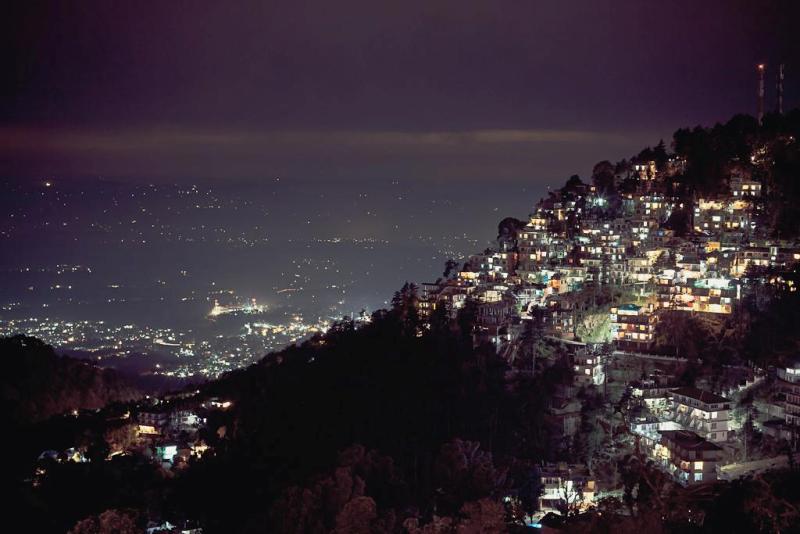It was neither the best of times nor the worst of times. We had lost everything of the old world charm, and gained much of the chaos of the new times. History was well behind us and the future looked bleak. With every haunted house inhabited, the crowds had forever banished those harmless, charming ghosts that dwelt amongst old, abandoned cottages and above damp, dark Springs of the two quaint hill stations, now spreading like wild fire in a dry Chir pine forest.
Simla, the aging-yet-growing ‘Queen of Hill Stations’ with an appropriately illustrious but equally scandalous history and ‘Divine Dharamsala’, with much to thank the Dalai Lama for taking the place heaven-ward, having made it to the future Smart Cities list (in the second ‘heats’), stand (actually sit), as it were, atop a hill, latched to a para-glider and waiting for the windfall (of Central funds) to sweep them up and away from the grotesquely urbanizing vale of Kangra or the harsh reality of an ever expanding “Lower Bazaar” (i.e. Shimla) with nowhere to land. Quite simply, two ‘sores’ in the landscape have been chosen to be turned into look-alike beauty spots or oases, not in any pristine desert but in the midst of scattered mushrooming concrete jungles. A romantic anti-climax!
Our potential smart cities keep falling between two stools or rather three stools (as now the Central Government comes in with the moolah). As the ‘services’ watershed of a city keeps growing with its population and density going up, the infrastructure, connectivity, administrative and financial role and therefore clout of the State Government keeps multiplying and Municipal Corporations become increasingly sidelined, dependent and helpless. Delhi and its elected government is a classic example. The basic question then is, whether, unlike panchayats, will the State Government let Urban Bodies do their job and also support them?
The other major hurdle is that smart cities usually arbitrarily demarcate densely populated areas or towns (within Municipal limits) and there is little or nothing in the Plan for areas immediately adjoining such boundaries. Many such areas are actually an integral, if not legal, part of the city itself, like scattered, unplanned peri-urban agglomerations. Shimla is full of them. And then there are areas beyond on whose resources the city is fully dependent for its survival. So, under smart cities are we looking at a sort of ‘state of art’ city that starts and ends abruptly, like at a check post in the middle of a bazaar? A mini Singapore in the urban sprawl of Greater Mumbai or a ‘clean’ oasis in the middle of dirty wetlands!

In our fanciful fantasizing of smart cities, many, in fact numerous down to earth truths or irritants are being just glossed over. To dwell on just a few:
Sewage and Septage (the muck that clogs our skeptic septic tanks!): I do not know how much of Dharamsala and surrounds is connected to a piped sewage system, but a lot of Shimla is not and neither do its STPs work (remember the jaundice epidemic?). In the hills ‘stations’ most toilets flush into septic tanks that may or may not be working. Presently, cleaning or repairing them seems impossible.
Drainage and Garbage: Like so much else, our drains are perpetually clogged. Rain water then flows on to roads and retaining walls, damaging both. It is not just the problem with the drain designs but more importantly with keeping them clean. There is this pervasive, perpetual stink emanating from the drains of nearly all bazaars in towns of Himachal. So much has been written about our growing garbage crises and our near total failure to effectively manage it. The connection between the so called monkey menace and freely available garbage does not seem to have got ‘connected’ among the city’s think tanks. Monkeys BTW meticulously sort out the degradable from the non-degradable garbage. We could learn the first step in garbage management from them.

Drinking water: Here is a crisis that won’t go away. It will actually get worse. Reason: ridiculously low water charges and the related non maintenance of supply systems. Wonder whether smart cities will insist on roof water harvesting?
Green spaces and play grounds: The trend of shrinking green spaces and insidious removal of trees, without any credible and sustained replacement is tied up with the political economy of urban land prices, encroachment and inability (or unwillingness) to enforce laws equally. It is unlikely that smart cities will unleash the necessary political will to stop and reverse these trends.
Most urban children today, especially in Himachal are now even unable to play (cricket?) on the streets (their earlier haunts) because of the growing and callous traffic. Or do we envision a future where children should be happy playing video games on their smart phones in free Wi-Fi (ed) smart cities?

And finally TRAFFIC: The tipping point when urban traffic becomes a constant threat to life and limb and stealthy a health hazard, has been reached. More so in Shimla, traffic jams and no place to park, besides the daily dose of grime and toxic exhaust, is now a part of the environment, like the weather, and there is no getting away from it. Compromise ‘solutions’ and total lack of foresight in urban planning have brought us to this pass. To expect that a city by being called ‘smart’ will magically make this urban dystopia vanish is like burying one’s head in the sand (sorry grime).
Two smart cities oscillating between “the age of wisdom and the age of foolishness”, with vastly different SWOTS but both headed towards a shared super-bright LED lit urban quicksand; one that has gone digital with fancy hardware imported from the future but run on software with a history of ‘existential’ malfunction from the past.
Yet, hope springs eternal!
Nodnat – is a pen name that the writer with deep knowledge of Himalayan flora and fauna and a keen environmentalist has adopted. He hails from Kotgarh, in Shimla Hills and retired as Principal Chief Conservator of Forests from Himachal Pradesh forest department.



